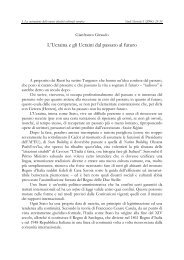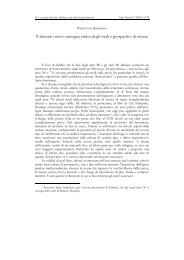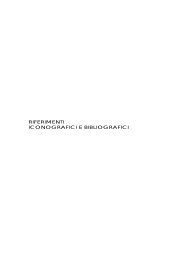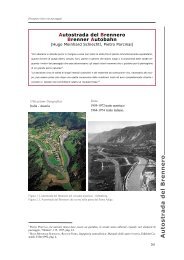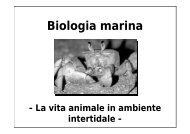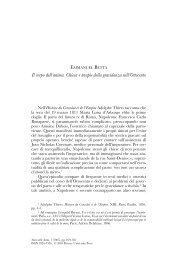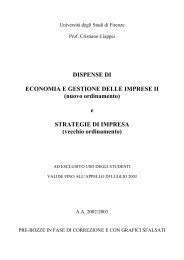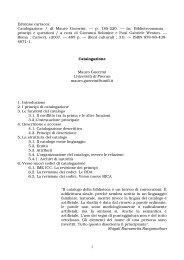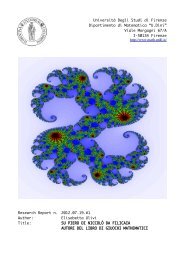204Strumenti della rete e processo formativoSharon Y., Sharon S. (1998), Gli alunni fanno ricerca. L’appren<strong>di</strong>mento in gruppicooperativi, Erickson, TrentoShort J.A., Williams E., Christie B. (1976), The social psychology of telecommunications,John Wiley & Sons, LondonSimoff S.J. (1999), Monitoring and Evaluation in Collaborative Learning Environments, inProcee<strong>di</strong>ngs of the International Conference on Computer supported CollaborativeLearning - CSCL'99, Stanford, Stanford University.Simone R. (2000), La terza fase. Forme <strong>di</strong> sapere che stiamo perdendo, Laterza, Roma-BariSitkin S., Sutcliffe K., Barrios-Choplin J. (1992), Determinants of communication me<strong>di</strong>achoice in organizations: A dual function perspective, in Human CommunicationResearch, 18, p. 463-498Skinner B.F. (1954), The science of learning and the art of teaching, in HardvardEducational Review, vol. 24, n. 2, pp.86-97, ed. Ita. 1970, La tecnologiadell’insegnamento, La scuola, BresciaSkinner B.F. (1958), Teaching Machines, in Sciences, 128, 1958, pp. 969-977Slavin R.E. (1983), Cooperative Learning, Longman, New YorkSlavin R.E. (1986), Appren<strong>di</strong>mento Cooperativo: una proposta <strong>di</strong> conciliazione traprospettive evolutive e motivazionali, in Età Evolutiva, 24, pp. 54-61Slavin, R.E. (1987), Cooperative learning and the cooperative school, in EducationalLeadership, 45(4), p. 7-13Smith J.B. (1994), Collective intelligence in computer based collaboration, LawrenceErlbaum Associates, New JerseySmith J.D., Coenders M.J. (2002), E-feedback to reflect legitimate peripheral participation.Towards a redefinition of feedback in online learning environments, documentopresentato al AACE E-Learn 2002 Conference, Montreal, Canada, 15-19 October 2002,Learning Allinaces, Portland, OR, in internet all’in<strong>di</strong>rizzo:http://www.learningalliances.netSoller A.L. (2001), Supporting social interaction in an intelligent collaborative learningsystem, in International Journal of Artificial Intelligence in Education, 12(2001), pp. 40-62.Spiro R., Feltovich P.J., Jacobson M.J., Coulson R.L. (1995), Cognitive Flexibility,Constructivism and Hypertext: Random Access Instruction for Advanced KnowledgeAcquisition, in Steffe, Gale, Constructivism in Education, Lawrence Erlbaum Associates,New Jersey, pp. 85-107Sproull L, Kiesler S. (1986), Reducing Social Context Cues: Electronic Mail inOrganizational Communication, in British Journal of Social Psychology, 29, p. 121-134Stahl G. (2002), CSCL goes to school, Paper presented at the CRIWG ‘02, La Serena, Chile,in Internet: http://www.cis.drexel.edu/faculty/gerry/cscl/papers/ch11.pdfSternberg, R.J. (1990), Metaphors of mind. Conceptions of the nature of intelligence,Cambridge University Press, Cambridge NYStoll S. (2001), Confessioni <strong>di</strong> un eretico high-tech, perché i computer nelle scuole nonservono ed altre considerazioni sulle nuove tecnologie, Garzanti, MilanoStriano M. (1999), I tempi e I “luoghi” dell’apprendere. Processo <strong>di</strong> appren<strong>di</strong>mento econtesti <strong>di</strong> formazione, Liguori, Napoli
Strumenti della rete e processo formativo 205Suchman L.A. (1987), Plans and Situated Actions : The Problem of Human-MachineCommunication, Cambridge University Press, Cambridge NYSuchman L.A. (2003), Human/Machine Reconsidered, documento preparatorio alla secondae<strong>di</strong>zione <strong>di</strong> Suchman, 1987, Centre for Science <strong>Stu<strong>di</strong></strong>es, Lancaster University, Lancaster.Disponibile in rete all’in<strong>di</strong>rizzo: http://www.comp.lancs.ac.uk/sociology/papers/suchmanhuman-machine-reconsidered.pdfSuper C.M., Harkness S. (1986), The developmental niche: a conceptualization at theinterface of child and culture, in International Journal of Behavioral Development, 9,pp.545-569Tamagnini G. (1965), Didattica operativa, Ed. MCE, FrontaleTaylor R.P. (1980), The computer in the school: Tutor, Tool, Tutee, Teacher College Press,Columbia University, New YorkToulmin S. (1958), The Uses of Argument, Cambridge University Press, New YorkTrentin G. (1998), Insegnare e apprendere in rete, Zanichelli, BolognaTrentin G. (1999), Telematica e formazione a <strong>di</strong>stanza, il caso Polaris, Angeli, MilanoTrentin G. (2001), Dalla formazione a <strong>di</strong>stanza all’appren<strong>di</strong>mento in rete, Angeli, MilanoTrevino L.K., Daft R.L., Lengel R.H. (1990), Understan<strong>di</strong>ng managers’ me<strong>di</strong>a choices: Asymbolic interactionist perspective, in J. Fulk, C. Steinfield (eds.), Organizations andCommunication Technology, Sage Publications, Newbury Park, CA, pp. 71-94TRIO (2003), Formazione a <strong>di</strong>stanza: riflessioni, metodologie, procedure. Le esperienzematurate nel progetto TRIO, Giunti, <strong>Firenze</strong>Trisciuzzi L. (1974), Cibernetica e appren<strong>di</strong>mento. La ricerca sperimentale in pedagogia,Teramo, EITTu C.H. (2002a), The Impacts of Text-based CMC on Online Social Presence, in TheJournal of Interactive Online Learning, Volume 1, Number 2, Fall 2002Tu C.H. (2002b), The Measurement of Social Presence in an Online Learning Environment,in International Journal on E-Learning, 1(2), p. 34-45Turkle S. (1997), La vita sullo schermo. Nuove identità e relazioni sociali nell’epoca <strong>di</strong>internet, Milano, Apogeo.Turoff M. (1995), Designing a Virtual Classroom, International Conference on ComputerAssisted Instruction – ICCAI, 7-10 March, 1995, National Chiao Tung University,Hsinchu, TaiwanValentini P. (1998), Jean Piaget: le opere, i meto<strong>di</strong>, il modello teorico, in Liverta Sempio O.(a cura <strong>di</strong>), Vygotskij, Piaget, Bruner. Concezioni dello sviluppo, Milano, RaffaelloCortina E<strong>di</strong>toreVarisco B.M. (1995a), Alle ra<strong>di</strong>ci dell’ipertestualità, in Calvani A., Varisco B.M. (a cura <strong>di</strong>),Costruire-decostruire significati, Cluep, Padova, pp. 1-87.Varisco B.M. (1995b), Para<strong>di</strong>gmi psicologici e pratiche <strong>di</strong>dattiche con il computer, in TD,E<strong>di</strong>zioni Menabò, Ortona, n. 7, pp. 57-68.Varisco B.M. (1998), Didattica e tecnologia dell’educazione: tra vecchi e nuovi para<strong>di</strong>gmi,in “<strong>Stu<strong>di</strong></strong>um educationis”, n. 4 - 1998 “Lineamenti <strong>di</strong> <strong>di</strong>dattica”, CEDAMVarisco B.M. (2002), Costruttivismo socio-culturale. Genesi filosofiche, sviluppi psicopedagogici,applicazioni <strong>di</strong>dattiche, Carocci, Roma
- Page 1 and 2:
TESIUMANISTICA- 3 -
- Page 3 and 4:
Giovanni BonaiutiStrumenti della re
- Page 5 and 6:
Strumenti della rete e processo for
- Page 7 and 8:
Strumenti della rete e processo for
- Page 9 and 10:
Strumenti della rete e processo for
- Page 11 and 12:
Teorie, modelli e artefatti per la
- Page 13 and 14:
Teorie, modelli e artefatti per la
- Page 15 and 16:
Teorie, modelli e artefatti per la
- Page 17 and 18:
Teorie, modelli e artefatti per la
- Page 19 and 20:
Teorie, modelli e artefatti per la
- Page 21 and 22:
Teorie, modelli e artefatti per la
- Page 23 and 24:
Teorie, modelli e artefatti per la
- Page 25 and 26:
Teorie, modelli e artefatti per la
- Page 27 and 28:
Teorie, modelli e artefatti per la
- Page 29 and 30:
Teorie, modelli e artefatti per la
- Page 31 and 32:
Teorie, modelli e artefatti per la
- Page 34 and 35:
32Strumenti della rete e processo f
- Page 36 and 37:
34Strumenti della rete e processo f
- Page 39 and 40:
Teorie, modelli e artefatti per la
- Page 41 and 42:
Teorie, modelli e artefatti per la
- Page 43 and 44:
Teorie, modelli e artefatti per la
- Page 45 and 46:
Teorie, modelli e artefatti per la
- Page 47 and 48:
Teorie, modelli e artefatti per la
- Page 49 and 50:
Teorie, modelli e artefatti per la
- Page 51 and 52:
Teorie, modelli e artefatti per la
- Page 53 and 54:
Teorie, modelli e artefatti per la
- Page 55 and 56:
Teorie, modelli e artefatti per la
- Page 57 and 58:
Teorie, modelli e artefatti per la
- Page 59 and 60:
Teorie, modelli e artefatti per la
- Page 61 and 62:
Strumenti e ambienti per la formazi
- Page 63 and 64:
Strumenti e ambienti per la formazi
- Page 65 and 66:
Strumenti e ambienti per la formazi
- Page 67 and 68:
Strumenti e ambienti per la formazi
- Page 69 and 70:
Strumenti e ambienti per la formazi
- Page 71 and 72:
Strumenti e ambienti per la formazi
- Page 73 and 74:
Strumenti e ambienti per la formazi
- Page 75 and 76:
Strumenti e ambienti per la formazi
- Page 77 and 78:
Strumenti e ambienti per la formazi
- Page 79 and 80:
Strumenti e ambienti per la formazi
- Page 81 and 82:
Strumenti e ambienti per la formazi
- Page 83 and 84:
Strumenti e ambienti per la formazi
- Page 85 and 86:
Strumenti e ambienti per la formazi
- Page 87 and 88:
Strumenti e ambienti per la formazi
- Page 89 and 90:
Strumenti e ambienti per la formazi
- Page 91 and 92:
Strumenti e ambienti per la formazi
- Page 93 and 94:
Strumenti e ambienti per la formazi
- Page 95 and 96:
Strumenti e ambienti per la formazi
- Page 97 and 98:
Strumenti e ambienti per la formazi
- Page 99 and 100:
Strumenti e ambienti per la formazi
- Page 101 and 102:
Strumenti e ambienti per la formazi
- Page 103 and 104:
Strumenti e ambienti per la formazi
- Page 105 and 106:
Strumenti e ambienti per la formazi
- Page 107 and 108:
Strumenti e ambienti per la formazi
- Page 109 and 110:
Strumenti e ambienti per la formazi
- Page 111 and 112:
Strumenti e ambienti per la formazi
- Page 113 and 114:
Strumenti e ambienti per la formazi
- Page 115 and 116:
Strumenti e ambienti per la formazi
- Page 117 and 118:
Strumenti e ambienti per la formazi
- Page 119 and 120:
Strumenti e ambienti per la formazi
- Page 121 and 122:
Strumenti e ambienti per la formazi
- Page 123 and 124:
Strumenti e ambienti per la formazi
- Page 125 and 126:
Strumenti e ambienti per la formazi
- Page 127 and 128:
Strumenti e ambienti per la formazi
- Page 129 and 130:
L’indagine empirica e le verifich
- Page 131 and 132:
L’indagine empirica e le verifich
- Page 133 and 134:
L’indagine empirica e le verifich
- Page 135 and 136:
L’indagine empirica e le verifich
- Page 137 and 138:
L’indagine empirica e le verifich
- Page 139 and 140:
L’indagine empirica e le verifich
- Page 141 and 142:
L’indagine empirica e le verifich
- Page 143 and 144:
L’indagine empirica e le verifich
- Page 145 and 146:
L’indagine empirica e le verifich
- Page 147 and 148:
L’indagine empirica e le verifich
- Page 149 and 150:
L’indagine empirica e le verifich
- Page 151 and 152:
L’indagine empirica e le verifich
- Page 153 and 154:
L’indagine empirica e le verifich
- Page 155 and 156: L’indagine empirica e le verifich
- Page 157 and 158: L’indagine empirica e le verifich
- Page 159 and 160: L’indagine empirica e le verifich
- Page 161 and 162: L’indagine empirica e le verifich
- Page 163 and 164: L’indagine empirica e le verifich
- Page 165 and 166: L’indagine empirica e le verifich
- Page 167 and 168: L’indagine empirica e le verifich
- Page 169 and 170: L’indagine empirica e le verifich
- Page 171 and 172: L’indagine empirica e le verifich
- Page 173 and 174: L’indagine empirica e le verifich
- Page 175 and 176: L’indagine empirica e le verifich
- Page 177 and 178: Strumenti della rete e processo for
- Page 179 and 180: Strumenti della rete e processo for
- Page 181 and 182: Strumenti della rete e processo for
- Page 183 and 184: Strumenti della rete e processo for
- Page 185 and 186: Strumenti della rete e processo for
- Page 187 and 188: Strumenti della rete e processo for
- Page 189 and 190: Strumenti della rete e processo for
- Page 191 and 192: Strumenti della rete e processo for
- Page 193 and 194: Strumenti della rete e processo for
- Page 195 and 196: Strumenti della rete e processo for
- Page 197 and 198: Strumenti della rete e processo for
- Page 199 and 200: Strumenti della rete e processo for
- Page 201 and 202: Strumenti della rete e processo for
- Page 203 and 204: Strumenti della rete e processo for
- Page 205: Strumenti della rete e processo for
- Page 209: RingraziamentiRingrazio nella perso



